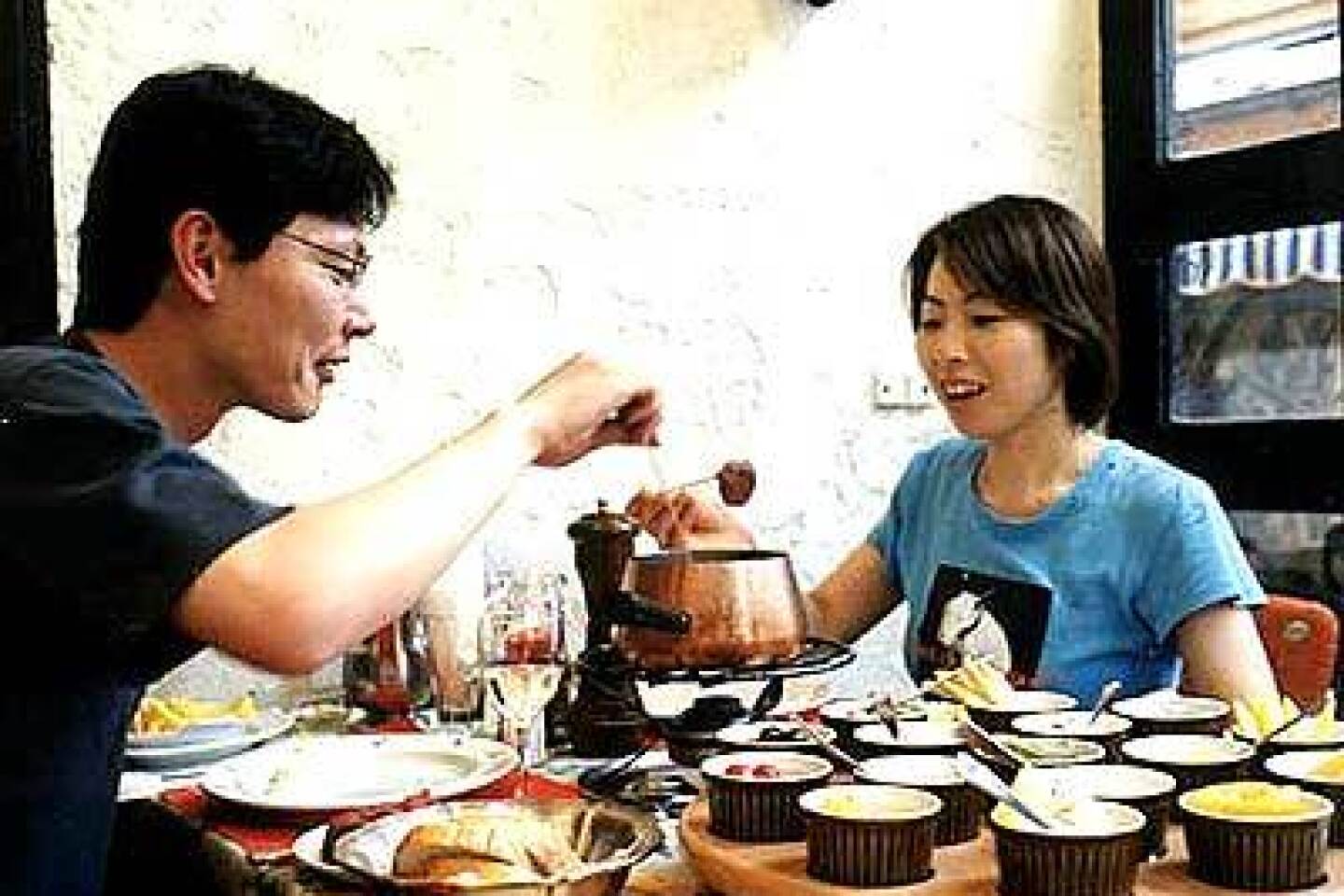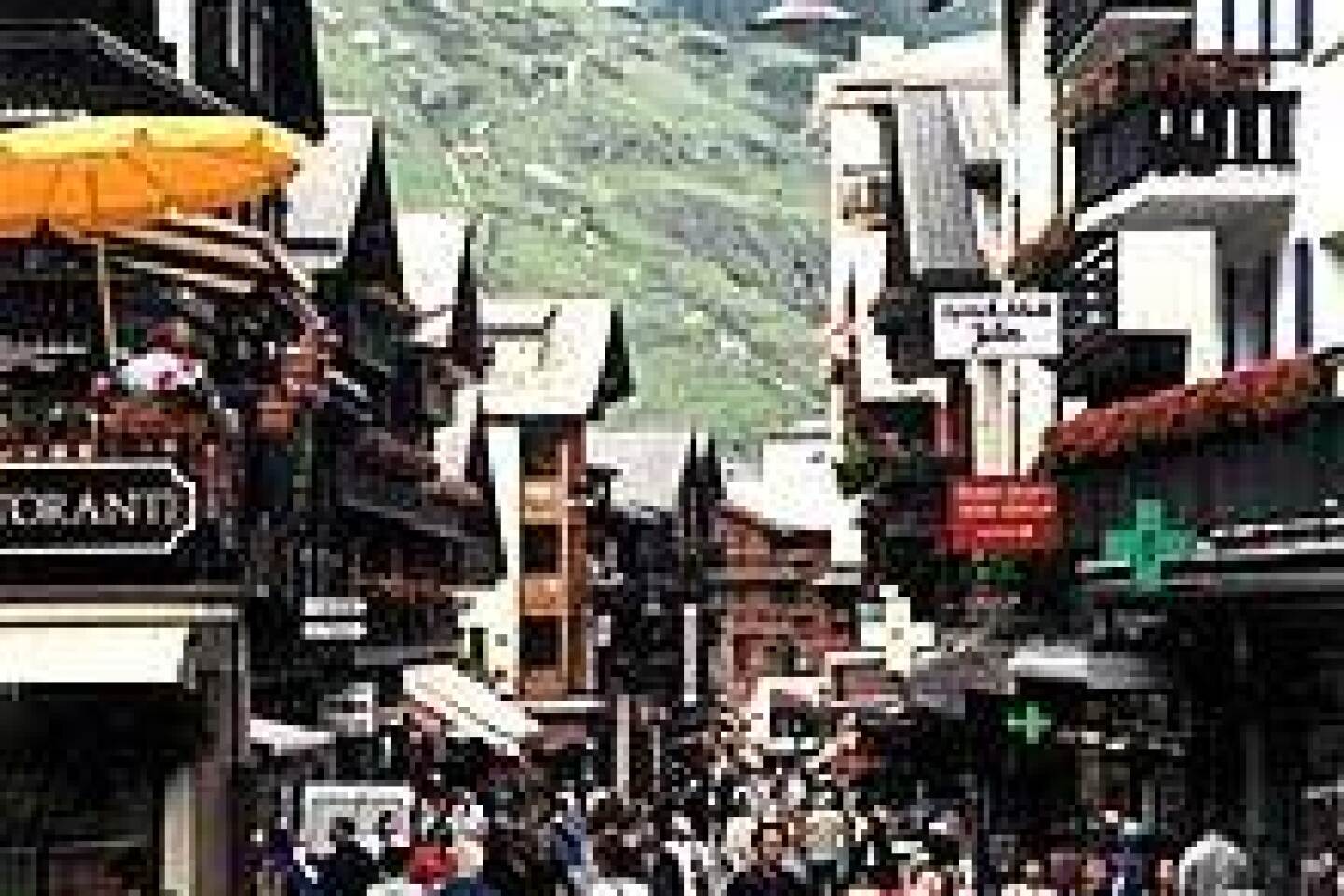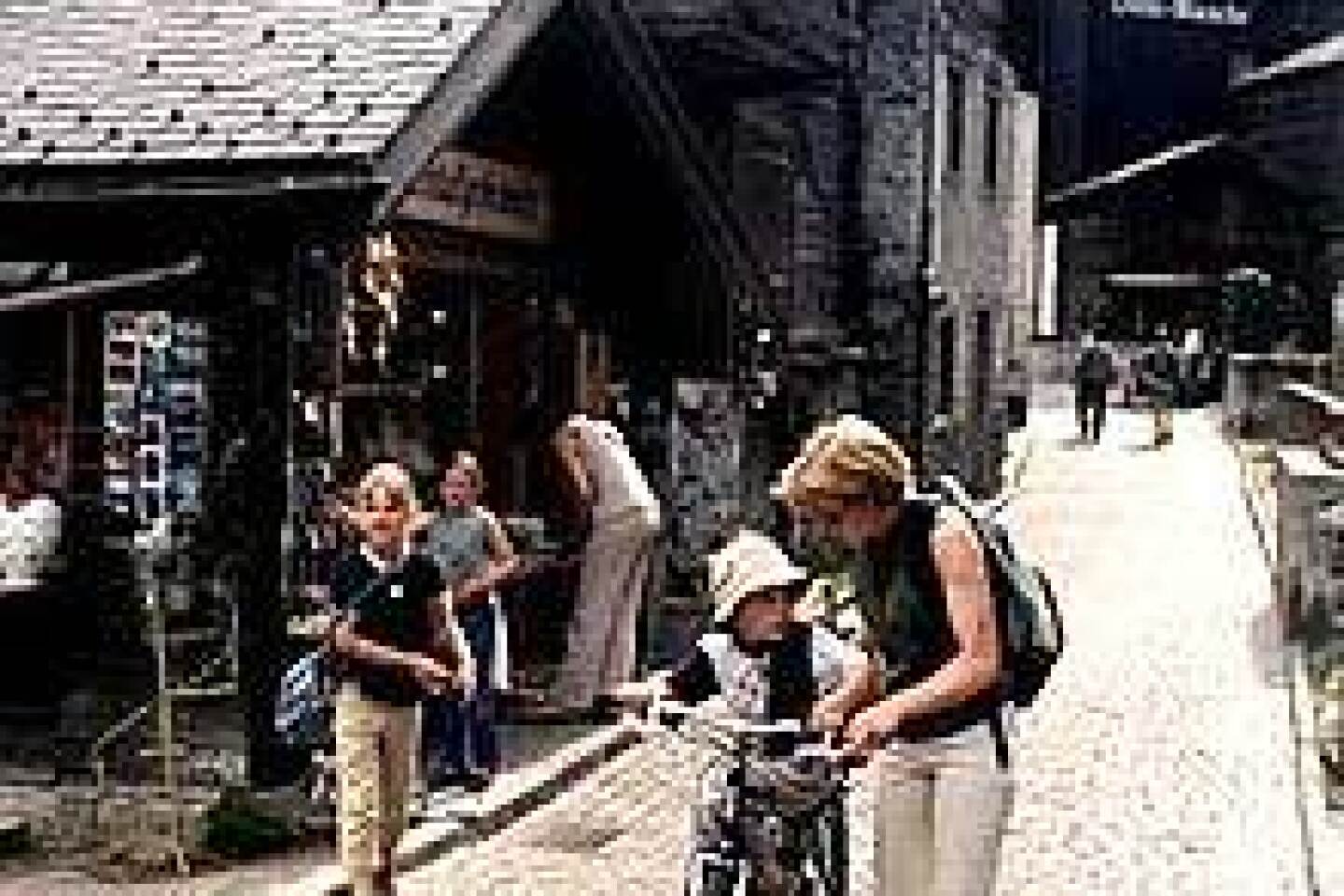Finding Swiss Bliss in Zermatt
If the Swiss ran the world, trains and planes would be on time. Every hotel room would have a view, and reservations would never be lost. Communicating would be easy because the Swiss seem able to speak whatever language you greet them in. You would never have a bad meal. In fact, nothing bad would ever happen.
To the casual observer, the Swiss run their country with a by-the-book precision that is no empty cliché, as I discovered last month spending a week in Zermatt, a mile-high village in the heart of the Alps. A winter skiing center so close to Italy that you can get there by lift, Zermatt is wedged between mountains at the end of a deeply cut valley, with the fabled Matterhorn looming to the southwest, solitary and singular. In summer when the snow melts and the wildflowers bloom, it is a classic Alpine postcard of a place, cozy, traditional, family oriented, right out of “Heidi.”
Just getting there is a sightseer’s delight and a lesson in Swiss managerial expertise. I flew to Zürich airport, which has a railway station. A ticket clerk confirmed the schedule I found on the Internet before leaving home, complete with the train and track numbers for my two connections to Zermatt.
The last leg of the six-hour train trip was on a trunk line that follows the cloudy, glacier-fed Vispa River, hugging the mountainsides, crossing and recrossing the waterway like a high-strung filly. There is a road through the valley as well. But cars are allowed only as far as the hamlet of Täsch, about five miles north of Zermatt, where drivers must leave their vehicles and continue by train or electric taxi, which is a little like a golf cart.
Horse-drawn carriages and whining electric cabs wait outside the train station in Zermatt to take arrivals to their hotels, most of which are Alpine chalets with balconies and flower boxes, the models for the phony ones you see in tourist traps. Then you look up and gasp as you see the Matterhorn, too boldly sculpted and invincible to seem hackneyed. You find yourself repeatedly going to the window to make sure it’s still there.
My room at the immaculate Hotel Biner, where I stayed the first two nights, had a balcony with a view across Zermatt’s vegetable gardens and slate roofs to the Matterhorn. I had booked a double for $145, including breakfast, but when I arrived, the front-desk clerk said I should take a single for $66. It wasn’t the money; it was as though he felt it only right that a solo traveler stay in a single room.
I loved the view and the orderliness of the room, which had simple pine furniture, a single bed covered with a duvet and a full bath with faucets that took me awhile to figure out. The breakfast buffet was a typically Swiss fortifying feast: muesli, fruit, hard-boiled eggs, cold cuts, cheese, rye bread, pastry and good, strong coffee.
During my first evening stroll, I quickly discovered that this village of 5,600 isn’t as small as it seems, sprawling up the sides of the valley. Cranes were poised over the central square where a hotel conference center is being built, and Bahnhofstrasse, the main artery, has Benetton, Patagonia, a Swatch outlet, myriad outdoors outfitters and kitschy souvenir shops where tourists buy Swiss Army knives.
Bahnhofstrasse is intersected by winding alleyways lined with old-fashioned larchwood storehouses and stables. Chalkboards outside restaurants advertise traditional Swiss fare: fondue, raclette (a melted cheese dish), rösti (like hash brown potatoes). The signs are in German, which predominates in Zermatt although the village is near the French-speaking section of Switzerland and just across the mountains from Italy.
In the mornings it is clear why people come to Zermatt in the summer. There is skiing at high altitudes, where snow always clings to the mountains. It is also a mountain walker’s paradise, where the risks are few and the pleasures of the scenery great. They come out after breakfast with rucksacks and walking sticks and head toward paths that lead to meadow-encircled hamlets with lonely little chapels, then upward to tundra, Alpine lakes, scree, snow and ice.
The mountains nearby look as steep and forbidding as the Grand Tetons of Wyoming or the Canadian Rockies. But the hand of man has made them extraordinarily accessible by a network of railways, ski lifts and cable cars, including the highest in Europe, which terminates at 12,533 feet near the top of the Klein (or Little) Matterhorn. Sightseers can take an aerial cableway or train into the mountains and walk back to the village, downhill all the way.
Of course, serious Alpinists come to Zermatt, complete with crampons (spikes attached to hiking boots for snow and ice) and ice axes, to climb the 14,691-foot Matterhorn or nearby peaks considered technically harder, like Dent d’Hérens and the Weisshorn. In season and in fair weather, 200 climbers a day sometimes reach the top of the Matterhorn, usually with a Swiss mountain guide from the Alpin Center in town. Blind climbers, amputees, 90-year-olds and a French violinist who played Bach on the summit have all made it up the Matterhorn.
The mountain is a demanding climb, testing the most experienced Alpinists and striking fear in the hearts of those who know its tragedies. The first and most unforgettable of these occurred July 14, 1865, the day the Matterhorn was finally conquered, after a party of seven climbers, led by Englishman Edward Whymper, successfully raced for the summit against a team of climbers approaching from the Italian side of the infamous Alp. Whymper’s group was coming down from the top, roped together, when one man lost his footing and fell, dragging three others to their deaths. Then the rope broke, saving Whymper and two Swiss guides.
Strangely, the accident put Zermatt on the map, attracting mountaineers from everywhere, above all Britons during the Victorian era. And Zermatt still has a decidedly English air.
The Hotel Monte Rosa at the center of the village bears a plaque commemorating Whymper, who stayed there before his bitter victory. Above it is poised little St. Peter’s Anglican church, built in 1869 for English climbers and fresh-air vacationers. It contains the remains of Charles Hudson, the Lincolnshire clergyman who died on the first ascent of the Matterhorn with others in the Whymper party.
I spent more than an hour in Zermatt’s Alpine Museum, below the English church. It has a stuffed mountain goat known as an ibex; a topo model of the Monte Rosa massif, which bounds Zermatt to the south; and a room devoted to Alpine tragedies. Most compelling to me was the rope that broke on the first ascent of the Matterhorn, frayed and weak-looking in its case, and a letter written by Whymper shortly after the calamity, saying of the mountain, “Now the very name of it is hateful to me.”
The next day I walked about 45 minutes to the hamlet of Blatten, really just a cluster of rustic houses and stables. There I had a picnic lunch of soft cheese on a rye croissant from the grocery in Zermatt, while I waited for clouds to disperse around the Matterhorn so I could photograph it.
I walked for about half an hour on to Furi, which has a lift station. There I got into the car to Klein Matterhorn. At the last minute, I changed my mind for no particular reason and switched to the car to the Furgg lift station, underneath the Theodul Glacier. I realized as soon as the door closed that I had left my camera behind. I told the attendant about it in French, then in English and then in frantic sign language. Patting my shoulder, he told me in one of those languages--I don’t remember which--to go on up to the Schwarzsee lift stop on the Matterhorn’s shoulder, then said, “Ciao.”
There’s something about Swiss men you don’t want to contradict, so I did as I was bidden. On the way, I joined a group of Japanese tourists, who spoke English and commiserated with me about the loss of my camera. “Yes, yes, an Olympus,” one of them said, shaking his head dramatically.
At the Schwarzsee stop, near the bottom of the Matterhorn’s easiest ridge to climb, there’s a hotel with, as usual, pristine public bathrooms and a cafe where I had a cup of tea. While contemplating the stupendous scenery, I thought how civilized it was of the Swiss to provide mountaineers with places like this. No need to get grubby and camp out. Indeed, there’s a hotel even higher on the Big M, the Belvedere, at 10,700 feet.
After an hour’s respite at Schwarzsee, I went back down to the Furi station. There the attendant returned my camera, which had ridden up the Klein Matterhorn in the other car without me. When my new Japanese friends saw it hanging from my shoulder, they applauded.
This little expedition was hardly enough conditioning for the Matterhorn, but trying a little Swiss snow and ice climbing appealed to me nonetheless. The clerk at the Alpin Center in Zermatt said the hike up the Breithorn, a 13,685-foot peak, was easy, starting at the Klein Matterhorn cable car stop and ascending 1,456 feet to the summit. So I booked a trip (for $93) with a guide and two other people, then went to an outfitter in town to rent crampons, a climbing harness, gloves, a ski pole and an ice ax.
The weather was perfect. I made it to the top of the Breithorn in shirt sleeves. From there I saw the valleys that push into the Alps from Italy; Zermatt to the north; the Matterhorn completely unveiled, as if on a coin; and, far to the west, Mont Blanc.
That, however, is the only positive thing I can say about an otherwise miserable experience. Urs, my happy, helpful Swiss mountain guide, who said he had climbed the Matterhorn 200 times, could have put Spanish Inquisition torturers to shame. Maybe I overestimated my fitness and underestimated the need to get used to the altitude and the challenges of the climb. But after we made it over the shoulder between Klein Matterhorn and the Breithorn in hiking boots and put on crampons, I faltered. With every step, my feet sank into the snow, which is to be expected but makes the walking hard, especially on an incline.
“Urs,” I cried, “can’t we go a little slower?”
“If we go any slower,” he said, “we stop.”
Then he tugged the rope that connected us, not gently. I kept trying to joke with him, but apparently he didn’t share my sense of humor.
At the top I plopped down on the Breithorn’s snowcap and ate a protein bar, and for awhile I felt exhilarated. But by the time I was back down in Zermatt, my body felt like a junkyard, I’d caught a cold and my face was burned because I hadn’t used sunscreen.
Walking adventures that were more pleasant followed. I moved for two nights to the Hotel Riffelberg, at the third-to-last stop of the Gornergrat railway. You can see it from Zermatt below, sitting in splendid isolation above the tree line at 8,471 feet, on an Alpine meadow dappled by wildflowers and marmot holes.
There I paid $92 a night, including breakfast and a four-course, set-menu dinner, for a single room with a carved pine bedstead and armoire, TV, telephone, full bath and casement window.
The morning after I arrived, I took the train to its terminus beside the Gornergrat glacier, where there’s another hotel, restaurant and snack shop. Outside the station, several enterprising Swiss had set up a photographic concession, taking pictures of Japanese tour groups with sleepy Saint Bernards wearing whiskey kegs around their necks.
Back down one stop, I got out to walk, making my way carefully along a muddy path to Riffelsee, a lake that reflects the Matterhorn like a mirror. Just as I got there, I slipped and landed in the mud, which coated my backside from collar to heels. So I lay down on a rock by the lake to dry off. Soon an elderly Englishwoman ambled down the path, followed by her husband, who came over to me.
“I must tell you a story,” he said, then described how he and his wife had gone walking shortly after they married.
At one point she sat in a pile of deer scat, but he didn’t want to trouble her so he didn’t mention it. “All the way up the mountain, I followed the green blotch,” he said, laughing merrily at the memory.
This encounter put me in a perfect frame of mind for my last two days in Zermatt at the venerable Hotel Monte Rosa, where the service is faultless and a sense of decorum prevails. It opened in 1839 and has long been favored by vacationers from Great Britain.
There’s a pocket bar on the first floor with red tartan wallpaper, lined with vintage prints of mountains and climbers. The second floor has a billiards room and library. My single room on the third floor, about $148 including breakfast and dinner, had a balcony and elegant, traditional European furnishings.
The afternoon I checked in, the management held a cocktail party for guests, complete with beautiful canapés served on a silver platter. There I met a cast of characters out of an Agatha Christie novel: sedate English couples; a large, ruddy Scot; a Frenchman and his wife who stayed at the fringes of the group; a family from New Hampshire with three strapping teenage daughters; and a man from South Carolina who had been coming to the hotel for 40 years.
The South Carolinian sat at a single table next to mine in the dignified dining room, where the place settings had more forks than I knew what to do with, the butter came in little rosettes, and there was a cheese cart. The meal was a lavishly served and presented five-course affair, featuring potato cream soup, English roast beef and rhubarb tart. To accompany it, I ordered a split of Valais Dôle des Monts, a Swiss red that seemed tasty enough until my American friend offered me a glass of Châteauneuf-du-Pape, an exquisite French red prized by oenophiles. I sat musing.
I had climbed the Breithorn and sat by the Riffelsee. Still, the Swiss had remained mostly unknowable to me, though their country really does run like a Rolex. Meanwhile, there was such good humor and conviviality in the dining room at the Monte Rosa, full of happy tourists doing what they love in a magnificent setting, that these people and this meal remain my fondest memory of Zermatt.
Sign up for The Wild
We’ll help you find the best places to hike, bike and run, as well as the perfect silent spots for meditation and yoga.
You may occasionally receive promotional content from the Los Angeles Times.







